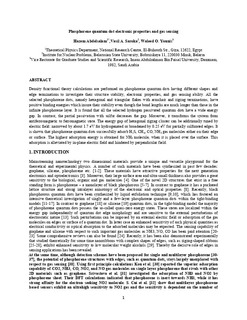| dc.contributor.author | Abdelsalam, H. | |
| dc.contributor.author | Saroka, Vasil | |
| dc.contributor.author | Younis, W.O. | |
| dc.date.accessioned | 2019-05-03T06:47:40Z | |
| dc.date.available | 2019-05-03T06:47:40Z | |
| dc.date.created | 2019-01-22T17:52:06Z | |
| dc.date.issued | 2019 | |
| dc.identifier.citation | Physica. E, Low-Dimensional systems and nanostructures. 2019, 107 105-109. | nb_NO |
| dc.identifier.issn | 1386-9477 | |
| dc.identifier.uri | http://hdl.handle.net/11250/2596384 | |
| dc.description.abstract | Density functional theory calculations are performed on phosphorene quantum dots having different shapes and edge terminations to investigate their structure stability, electronic properties, and gas sensing ability. All the selected phosphorene dots, namely hexagonal and triangular flakes with armchair and zigzag terminations, have positive binding energies which insure their stability even though the bond lengths are much longer than those in the infinite phosphorene layer. It is found that all the selected hydrogen passivated quantum dots have a wide energy gap. In contrast, the partial passivation with sulfur decreases the gap. Moreover, it transforms the system from antiferromagnetic to ferromagnetic state. The energy gap of hexagonal zigzag cluster can be additionally tuned by electric field: narrowed by about 1.7 eV for hydrogenated or broadened by 0.25 eV for partially sulfurated edges. It is shown that phosphorene quantum dots successfully adsorb H2S, CH4, CO, NH3 gas molecules either on their edge or surface. The highest adsorption energy is obtained for NH3 molecule, when it is placed over the surface. This adsorption is alleviated by in-plane electric field and hindered by perpendicular field | nb_NO |
| dc.description.abstract | Phosphorene quantum dot electronic properties and gas sensing | nb_NO |
| dc.language.iso | eng | nb_NO |
| dc.publisher | Elsevier | nb_NO |
| dc.relation.uri | https://doi.org/10.1016/j.physe.2018.11.012 | |
| dc.rights | Attribution-NonCommercial-NoDerivatives 4.0 Internasjonal | * |
| dc.rights.uri | http://creativecommons.org/licenses/by-nc-nd/4.0/deed.no | * |
| dc.subject | Tetthetsfunksjonal teori | nb_NO |
| dc.subject | Density functional theory | nb_NO |
| dc.title | Phosphorene quantum dot electronic properties and gas sensing | nb_NO |
| dc.type | Journal article | nb_NO |
| dc.type | Peer reviewed | nb_NO |
| dc.description.version | acceptedVersion | nb_NO |
| dc.subject.nsi | VDP::Teoretisk kjemi, kvantekjemi: 444 | nb_NO |
| dc.subject.nsi | VDP::Theoretical chemistry, quantum chemistry: 444 | nb_NO |
| dc.source.pagenumber | 105-109 | nb_NO |
| dc.source.volume | 107 | nb_NO |
| dc.source.journal | Physica. E, Low-Dimensional systems and nanostructures | nb_NO |
| dc.identifier.doi | 10.1016/j.physe.2018.11.012 | |
| dc.identifier.cristin | 1663268 | |
| dc.relation.project | EC/H2020/644076 | nb_NO |
| dc.description.localcode | © 2018. This is the authors’ accepted and refereed manuscript to the article. Locked until 12 November 2020 due to copyright restrictions. This manuscript version is made available under the CC-BY-NC-ND 4.0 license http://creativecommons.org/licenses/by-nc-nd/4.0/ | nb_NO |
| cristin.unitcode | 194,66,20,0 | |
| cristin.unitname | Institutt for fysikk | |
| cristin.ispublished | true | |
| cristin.fulltext | preprint | |
| cristin.qualitycode | 1 | |

